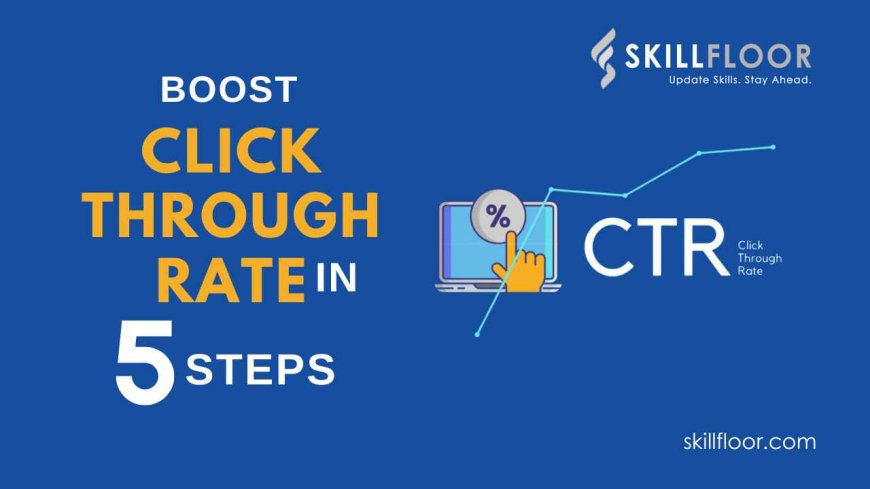Improve Your Click-Through Rate in 5 Steps
Learn 5 steps to increase your click-through rate (CTR) and get more traffic to your site. Improve your online presence with effective optimization strategies.

Hello, digital explorers! Are you finding that the attention your thoughtfully developed material deserves is being taken from it? You're not by yourself. Increasing your Click-Through rate can significantly shift the game by increasing the visibility of your content and drawing more users to your website. This blog post will discuss How to Improve Your Click-Through Rate in 5 Steps, diving into practical strategies that might enhance the attraction and clickability of your content. Your click-through rate will significantly increase if you concentrate on creating captivating headlines, improving meta descriptions, using rich snippets, utilizing images, and speeding up your website. Now, let's go out on this journey to improve your Click-Through rate and differentiate your material from others on the internet!
What is Click-Through Rate?
The metric referred to as click-through rate, or CTR in short, tells you how frequently a link is clicked after it has been shown. To get the percentage, divide the number of clicks on your link by the total impressions it receives, then multiply the result by 100. Your click-through rate is 10%; for example, if 100 individuals view your link and 10 of them click on it,. A higher click-through rate essentially indicates that more people are clicking on your content because they find it interesting or relevant. Increasing your click-through rate can result in more people visiting your website and interacting with your content more effectively overall.

Step 1: Craft Compelling Headlines
In the internet world, your title can be the first thing people see, and first impressions do count. This is your opportunity to catch their eye and convince them to click. The following advice can help you create headlines that increase your click-through rate:
Be Clear and Specific: Your headline should give a clear idea of what the content is about. Avoid vague titles that could apply to anything. For example, instead of Tips for Better Marketing, go for 10 Proven Marketing Strategies to Boost Your Sales.
Create a Sense of Urgency: Phrases like Don’t Miss Out or Limited Time Offer can encourage quick action. People are more likely to click when they feel they might miss something valuable.
Use Power Words: Words like secrets, ultimates, and hacks add a bit of punch to your headlines. They imply there’s something special inside, sparking curiosity.
Ask a Question: Questions engage readers by addressing their needs or piquing their curiosity. Want to double your sales in a month? is more engaging than just increasing your sales.
Keep It Short and Sweet: Aim for headlines under 60 characters. This ensures they’re fully visible in search results and easy to read at a glance.
Step 2: Optimize Meta Descriptions
Similar to the description seen on the back of a book, your meta description provides readers with an overview of what to expect. Even though it has no direct effect on your click-through rate, a strong meta description can have a big impact on it. How to maximize yours is as follows:
Add Your Primary Keyword: Keywords that correspond to the user's search query are highlighted by search engines. Your core keyword may stand out more if it is in the meta description.
Keep It Short and Useful: Try to limit your writing to 150–160 characters. This guarantees that your description appears in full in search results, without being cropped off.
Include a Call to Action: By informing readers of the benefits, phrases like Learn More, Find Out How, or Get Started Today can entice them to click.
Reflect the Content: Make sure your meta description appropriately sums up the contents. Although deceptive descriptions may increase clickthrough rates, they won't result in happy readers.
Step 3: Utilize Rich Snippets
Rich snippets provide additional information that makes your link stand out in search results, much like a fancy business card for your content. You can use them as follows to increase your click-through rate:
Add Schema Markup: One kind of microdata you may include in your HTML is schema markup. It makes your material easier for search engines to comprehend and presents it in a more appealing manner. Schema markup, for instance, can display the dish's photo, rating, and cooking time while constructing a recipe.
Emphasize Ratings and Reviews: Showcase your excellent ratings and reviews if you have them! Links that have received positive reviews from others have a higher click-through rate.
Incorporate Videos and photos: Thumbnails for videos or photos can also be shown in rich snippets. Visual content has a strong pull on the viewer and could be the perfect clicker.
Make Use of Lists and FAQs: Your link will look more enticing in search results if your information is organized as a list or contains frequently asked questions.
Step 4: Leverage Visuals
The adage that a picture is worth a thousand words is especially relevant when it comes to increasing your click-through rate. Here's how to make the most of visuals:
Employ High-Quality pictures: People may become disinterested in low-resolution or generic stock photographs. Make a quality visual investment that complements your content.
Include infographics: Infographics are a terrific method to convey complex or data-heavy information in a way that is easy to understand. Additionally, they are very shareable, which might increase website traffic
Incorporate Videos: Videos are quite interesting and can make people stay on your website for a longer period of time. Videos may improve your content, whether they be product demos, testimonials, or tutorials.
Optimize Visuals for SEO: Improve Your Visuals for SEO by giving your files meaningful names and providing alt text for your photos.
Step 5: Improve Page Speed
Let's discuss page speed last but definitely not least. Nobody enjoys watching a page load slowly. Here's how to make sure your page loads as quickly as possible:
Reduce the Size of Your Images: Loading large picture files can cause your page to lag. To compress them without sacrificing quality, use tools.
Enable Browser Caching: Turn on browser caching to save content on visitors' browsers and save them from having to reload your website every time they come.
Minimize HTTP Requests: Reduce the number of HTTP requests made by each element on your page (images, scripts, and CSS files). Your load time can be accelerated by lowering these.
Make use of a Content Delivery Network (CDN): A CDN keeps duplicates of your website in different places. It speeds up load times by serving visitors to your site from the nearest server.
Optimize Your Code: To make your website speed and lighter, tidy up your JavaScript, HTML, and CSS. Minify your code by eliminating whitespace and extra characters.
It's not difficult to increase your click-through rate (CTR). You can significantly improve your click-through rate and generate more visitors to your website by creating compelling headlines, improving your meta descriptions, using rich snippets, using images, and speeding up your page. Making the content engaging and simple for your audience to obtain is crucial. When you follow these instructions, your click-through rate will increase noticeably, improving engagement and increasing conversions.




























































